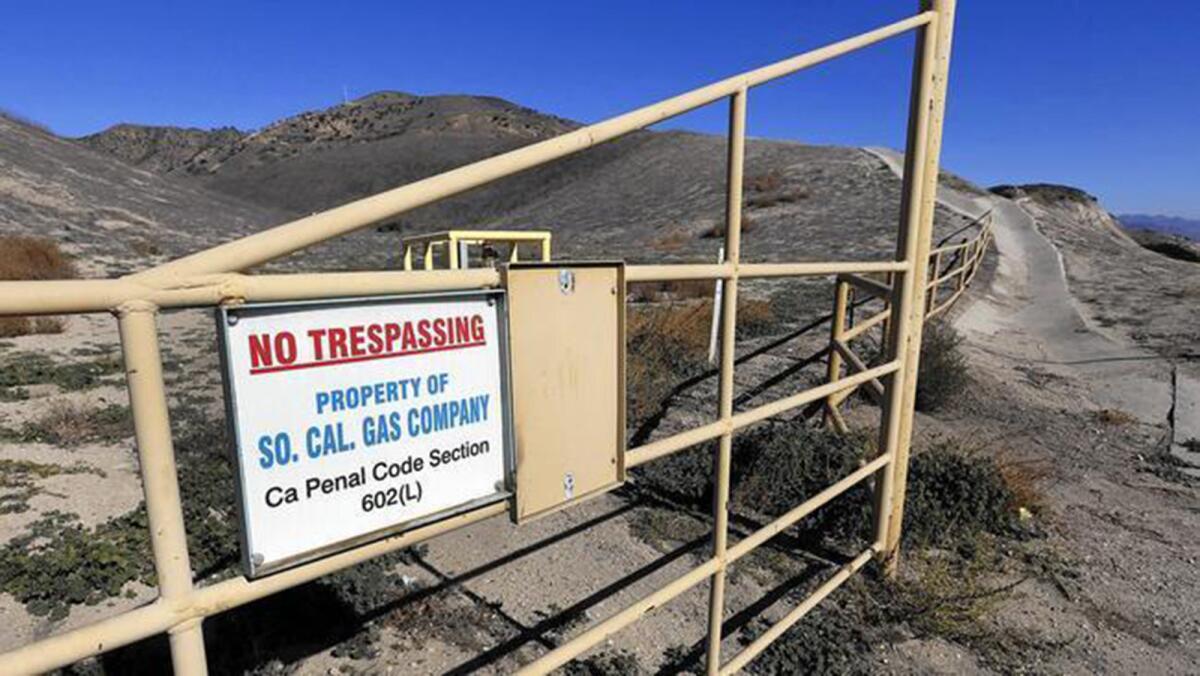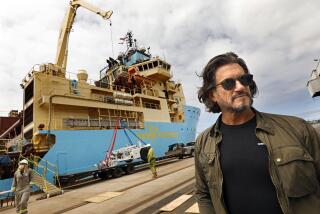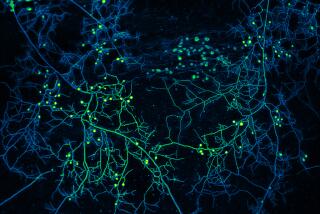Newly discovered soil microbes may have helped eat methane after Porter Ranch natural gas leak

The Aliso Canyon gas leak that forced thousands of people to leave their homes in Porter Ranch also had a dramatic impact on the area’s microscopic residents, new research shows.
In the area around the breach, Caltech scientists found a massive increase in previously unknown microbes that inhabit the soil and appear to consume ethane and possibly methane.
The discovery, described this week at an American Geophysical Union meeting in San Francisco, is prompting researchers to reconsider the nature of these gas-eating critters. It could also aid efforts to use microbes to clean up future environmental disasters.
The Aliso Canyon incident, which began in late October 2015, released approximately 95,000 tons of methane, along with ethane and other chemicals. By the time the leak was capped in February, it had become the largest natural gas leak in U.S. history.
Methane is less abundant than carbon dioxide, but it is a much more powerful greenhouse gas. Pound for pound, over 100 years, its effect on climate change is more than 25 times greater, according to the Environmental Protection Agency.
Caltech geobiologist Victoria Orphan has studied microorganisms that help lock methane away in carbonate rocks, keeping the greenhouse gas out of the atmosphere. Typically, she works with deep-sea microbes that live in darkness and under extreme pressure. Aliso Canyon provided an opportunity to study methane-eaters that were practically in her backyard.
What happens, she wondered, when the environment is flooded with methane? Could the usual methane-eating suspects handle the surge, or did new players rise to the challenge, marking a shift in the demographics of the microbial community?
So while thousands of Porter Ranch residents were displaced — with many complaining of headaches, nausea, nosebleeds and other health problems — Orphan and her colleagues made several trips to the area to collect the soil.
Orphan’s Caltech colleague Patricia Tavormina, who is also a microbiologist at Cal State Channel Islands, spearheaded the work.
“People are quick to go out and find out what’s happening during an oil spill in the ocean, and I thought it made sense to do the same thing in the soils,” Tavormina said.
The scientists sampled areas from about 40 yards to 2.5 miles from the Southern California Gas Co. leak site. They jammed PVC pipe about 20 inches into the earth, pulling up cylinders of soil that could be sampled at different depths.
That was the easy part.
Back in the lab, the samples threw the researchers for a loop. The typical methane-eating microbes in this soil community did not seem to be responding to the influx of natural gas. So the scientists ran a test looking for a wide array of enzymes with the ability to break down alkanes, a group of hydrocarbons that includes gases like methane and ethane.
The usual suspects were MIA, just as the usual microbes had been. But the scientists did discover plenty of an unexpected enzyme that seemed utterly out of place in the Porter Ranch soils. In fact, it was similar to one found in a very different type of bacteria that bloomed in the Gulf of Mexico after the 2010 Deepwater Horizon oil spill.
In Porter Ranch, however, this enzyme was being used by a previously unknown kind of Sphingobium microbe. Near the leak, these soil bacteria appeared to have experienced a massive population boom — the ones found near the rupture were about 100,000 times more abundant than those at spots that were farther from the leak. The scientists also saw the abundance of Sphingobium drop off over time, a sign that the surge was linked to the methane leak.
Here’s the really confusing part: The Sphingobium bacteria were not supposed to have this enzyme, and were not supposed to be eating methane in soil. That job was supposed to belong to other well-known microbes using different enzymes — which, in spite of the sudden abundance of natural gas, didn’t seem to be doing much at all.
How did deep-sea microbes and surface-soil microbes, living worlds apart and in vastly different conditions, both end up with these so-called Group X enzymes?
“I was not expecting it to show up there,” Orphan said. “And actually, the first time Patty said she had recovered this Group X, my initial feeling was, ‘Oh God, we contaminated something in the lab!’ But when she sequenced it, it was different enough from the ones we had recovered from Deepwater Horizon that we knew it wasn’t just lab contamination. This was a bona fide new branch on this tree.”
There was another strange thing about the enzyme: It wasn’t coded into the Sphingobium genome, as enzymes typically are.
Instead, the researchers suspect these Sphingobium bacteria got the gas-munching enzyme thanks to plasmids, little loops of DNA that exist outside of the bacteria’s main genomic hub. Plasmids can copy themselves independently and even be passed between microbes, just as construction workers might pass along a handy wrench or hammer.
“It’s like a little package of goodies — you can accessorize your capabilities with these little pieces of DNA,” Orphan said. “Things like antibiotic resistance [are] very often coded on plasmids. This is how, in some cases, resistance passes very quickly through a community of microorganisms.”
The scientists were able to culture the Sphingobium bacteria in the lab. They considered it a rare feat, as it’s very difficult to grow the marine microbes they usually work with.
In experiments, this new candidate species (currently dubbed Sphingobium alkanivorans, or ‘alkane-eater’) was able to eat ethane in a pure culture, but not methane. However, when they took that culture and returned it to its natural environment, methane levels in the soil went down too.
It’s unclear whether the microbes are consuming the methane directly, whether they’re helping a different species break it down or whether another species is doing all the work alone, Orphan said. Determining exactly why the methane is disappearing will take more research.
There are some early hints that Sphingobium might have an ally: The samples were highly enriched in other bacteria from the genus Massilia. It’s possible they were all working in cahoots to process the methane, though it’s not yet clear.
If these Sphingobium bacteria are cooperating with other microbes to break down methane, the scientists hope to gain fresh insights into the complex relationships between supposedly simple microorganisms — the kinds of interactions that Orphan has been probing in deep-sea microbes for years.
If these organisms do turn out to play some role in digesting methane, they can be studied and put to use.
See the most-read stories in Science this hour »
“You can develop it as a biotechnology, perhaps to use in fracking sites or feed lots or landfills or these sorts of things where methane is produced,” Tavormina said.
In some ways, the situation echoes the microbial response to marine oil spills: The hydrocarbon-digesting microbes that you expect to consume these products aren’t always the ones equipped to handle fast-changing situations.
Instead, the ones that will be useful for humans may be the ones that just happen to have the right tools for a particular situation. The key may be in these plasmid-encoded instructions, which probably lie dormant and ignored for long stretches of time until circumstances suddenly call upon them, Tavormina said.
Ultimately, understanding the mechanisms that allow a microbial community to respond to an event like the Aliso Canyon leak will help scientists harness the power of bacteria for future environmental disasters.
Follow @aminawrite on Twitter for more science news and “like” Los Angeles Times Science & Health on Facebook.
ALSO
To mobilize Trump’s America for environmental protection, invoke the past
E-cigarette use falls among teens for the first time, study finds
Personality trait or mental disorder? The same genes may weigh in on both







